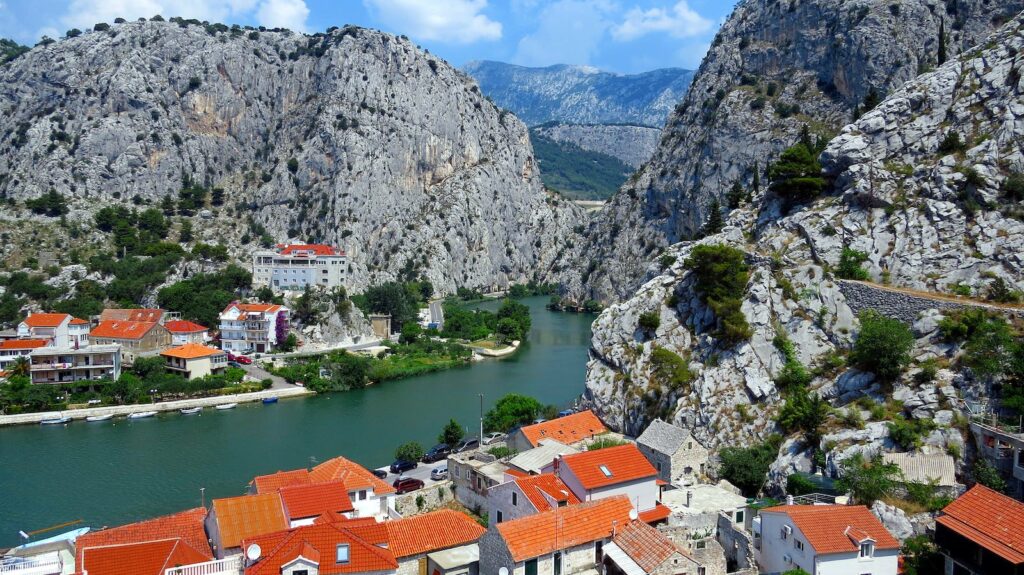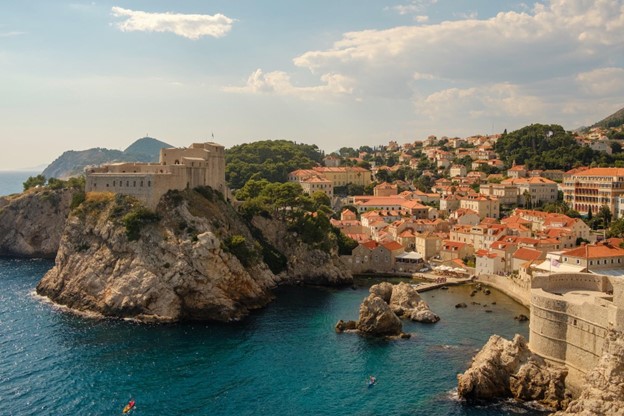
Croatia is a small yet diverse country situated at the crossroads between Central and Southeast Europe. Croatia offers travelers diverse experiences, from its culturally rich capital, Zagreb, to its stunning Adriatic coastline, Split.
Croatia has everything if you want to explore ancient ruins, enjoy delicious Mediterranean cuisine, hike mountain ranges, or simply lounge on pristine beaches.
Traveling through Croatia, you’ll discover a land of stark contrasts. The country has rugged mountain ranges, dense forests, crystal-clear waters, and pristine beaches. The grandeur of medieval walled cities and ancient fortresses will blow you away. Moreover, the small towns and villages dotted throughout the countryside will charm you.
Its architecture, museums, galleries, and festivals demonstrate Croatia’s rich cultural heritage. And, of course, you’ll have plenty of opportunities to sample Croatia’s delicious regional cuisine and fine wines.
So pack your bags and prepare for a 14-day itinerary that will take you through almost every region of this captivating country and leave you with unforgettable memories.
Overview of the 14-day itinerary to Croatia:
- Day 1-2: Zagreb
- Day 3–4: Plitvice Lakes National Park
- Day 5-6: Zadar
- Day 7–10 Split
- Day 11-14: Dubrovnik
Arrive in Croatia.
Though there are direct flights to Croatia, the cheaper option to arrive in Croatia is to fly to a major European city and then continue to Croatia by air. We recommend flying to London or Germany via Munich or Frankfurt, then arriving in Zagreb.
Zagreb Franjo Tudman Airport is the largest and busiest airport in Croatia. Zagreb is an ideal place to start your 14-day itinerary in Croatia since it is only ten kilometers from the airport. You can take a taxi, bus, or shuttle from the airport to get to the city’s center.
Day 1–2: Zagreb
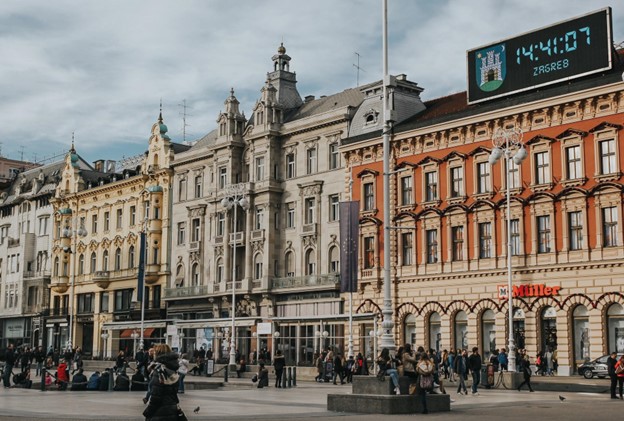
Zagreb
Zagreb will captivate you with its timeless beauty and rich cultural offerings. It is waiting for you to explore its fantastic sights, sounds, and tastes.
There are the most museums per square meter in Zagreb and quirky hidden gems that add to the city’s character. Strolling down the streets of this historic city, you will find public art, street food, and unique spots that reflect continental and Mediterranean cultures.
You can also join a bicycle tour to explore Zagreb, as it allows you to cover more ground than you would on foot while also enjoying the fresh air and sunshine. Several companies offer bicycle tours in Zagreb, each with a unique itinerary and focus.
Day 1: Explore the Upper Town
Welcome to Day 1 of your exciting 14-day Croatia itinerary! You’ve arrived in Zagreb, the perfect starting point for your Croatian adventure. Today, you’ll explore the Upper Town, where you’ll find some of the city’s most iconic and historical attractions.
The Upper Town of Zagreb has narrow streets stretching between Kaptol and Gradec Hills. The atmosphere here is more intimate and old-fashioned.
Trg Jelacica
Start your first day in Zagreb by heading to Trg Jelacica. It is the city’s central square, where people usually arrange to meet. Grab a hot cup of coffee and a sumptuous meal in the area’s numerous cafes, restaurants, and bars, and see how the people of Zagreb populate this busy square.
Zagreb Cathedral
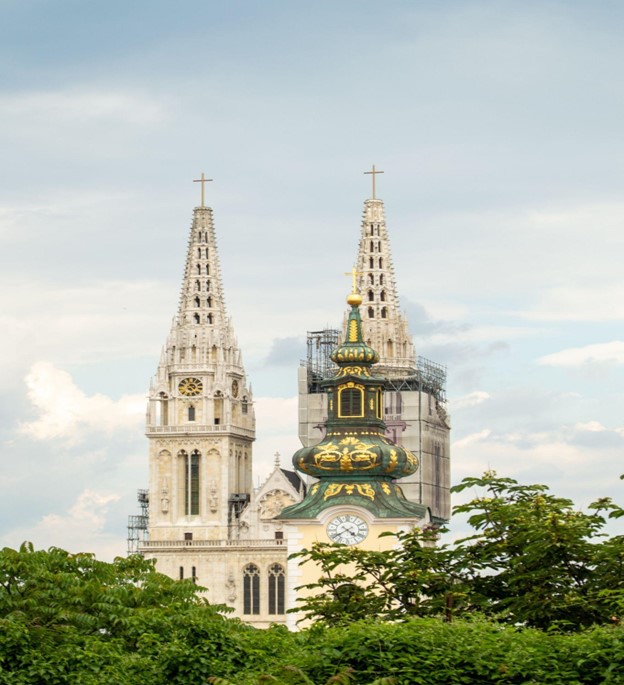
Zagreb Cathedral
Next, walk uphill to Kaptol, home to many historic landmarks and buildings. Zagreb Cathedral is one of the most notable infrastructures in the area. The cathedral is a stunning building that towers over the skyline of Zagreb.
During your visit, take your time to explore the intricate architecture of this magnificent cathedral while learning about its history. The best time to visit is during mass when you can also witness some of the city’s traditions. Furthermore, as one of the most monumental buildings in Croatia, you will not want to miss experiencing the beauty and grandeur of the Zagreb Cathedral.
Dolac Market
Next, head to Dolac Market, just a few minutes walk from the cathedral. The walk should take 10 minutes and is a good way to explore the city. Dolac Market is the biggest and most famous farmer’s market in Zagreb.
You can find fresh foods and a wide range of handmade crafts and souvenirs here. The most iconic feature of the market is the colorful umbrellas that cover the stalls, giving the place a festive and vibrant feel.
There are also several cafes and restaurants in the area, which is a perfect place to grab a drink and soak up the sights and sounds of the local life in Zagreb.
Zagreb 360
After wandering the bustling Dolac Market, head to the top of Zagreb 360, an observation deck in the city’s center. When you are in Zagreb, visiting Zagreb 360 should be on your bucket list. It offers a stunning panoramic view of the Old Town, Medieval Towers, and picturesque hills surrounding Zagreb.
To get to the top of the tower, take a high-speed elevator to the 16th floor, which stands at 120 meters high. Upon arrival, you will be greeted by a glass-enclosed deck to get an uninterrupted view of the city. It also has interactive screens that allow you to zoom in on different landmarks and learn about the history and culture of Zagreb.
One of the highlights of Zagreb 360 is that you can view the city from a bird’s eye view. On a clear day, you can even see as far as the snowy peaks of Julian’s Peak in Slovenia.
Strossmayer Promenade
Next, head to the Strossmayer Promenade. It is a scenic pathway that runs along the southern slope of Upper Town. It is a great spot for a leisurely stroll or romantic evening walk, as the promenade is lined with lush greenery and charming cafes and restaurants.
Locals and tourists would usually gather here in warm afternoons for a good sunset view. It offers an ideal spot to see the sun bathe the Lower Town in golden light. During sunset, the town’s skyline is painted orange, pink, and purple, making it a stunning backdrop to the cityscape.
Stone Gate
When you are in Zagreb, visiting the historic Stone Gate, a significant cultural and historical landmark, is a must. It is also one of the most visited places in Croatia. It is surrounded by narrow cobblestone streets and historic buildings.
As you walk through the gate, you’ll be transported back in time to medieval Zagreb. This beautiful and unique structure is an entrance and an important shrine for the people of Zagreb. You’ll be fascinated to learn about the legend surrounding Stone Gate and the locals’ devotion.
Museum of Broken Relationships
When in Zagreb, you surely can’t miss visiting the Museum of Broken Relations. It is a unique and full-of-emotions museum dedicated to how people cope with heartbreak and loss.
When you step inside the museum, you will be greeted by extensive collections of personal items donated by people worldwide. Each of which tells a story about failed relationships.
Day 2: Lower Town of Zagreb
After a day of exploring the Upper Town, you will descend into the Lower Town and discover its unique charm on your second day.
Unlike the Upper Town of Zagreb, the Lower Town is more dedicated to business. It is where you will find businesses, parks, and many museums.
Mimara Museum
The museum has a vast art collection, including paintings, sculptures, ceramics, and decorative items. It is one of the must-visit destinations for art lovers in Zagreb. As you wander through the museum’s hall, you will be mesmerized by the massive collection.
After exploring the museum, you can proceed to Zrinjevac Park. The park is known for its tree-lined pathways, fountains, and flower beds. Take a stroll through the beautiful Zrinjevac Park, which is just a short walk away, and stop for a refreshing beverage with a view.
Lenuci’s Green Horseshoe Park
Visit Lenuci’s Green Horseshoe for a relaxing and picturesque experience. It is the most famous museum in Zagreb and boasts an archaeological collection, a Far Eastern collection, art objects, and works by well-known European masters.
The park consists of several interconnected squares and parks that form the shape of a horseshoe, hence the name. You can walk around and explore the different parts of the park. You can also visit museums and galleries like the Croatian National Museum and the Museum of Arts and Crafts.
After exploring the park and nearby, museums, take a break and enjoy a cup of coffee or a meal at one of the cafes or restaurants located within the park. There are several options to choose from, including the Cafe de Paris in Zrinjevac Park and the Johann Franck Cafe near the Republic of Croatia Square.
Maksimir Park
Maksimir Park is a nature lover’s paradise. It is a perfect place for a relaxing day and offers many activities in the park.
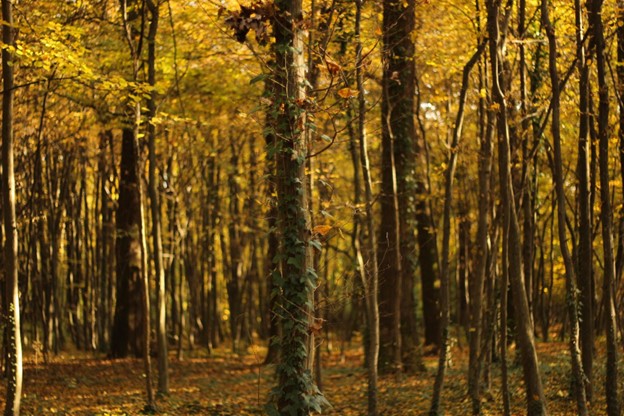
Maksimir Park covers an area of over 18 hectares and is home to a wide range of plant and animal species. The park features five lakes, numerous walking and cycling paths, and various recreational facilities. It has several entrance points and is easily accessible by public transportation.
Maksimir Park is the oldest public park in Zagreb. It is part of Zagreb’s cultural heritage. The park’s green spaces provide a restful setting and allow you to take a break from the hustle and bustle of the city.
The park’s well-maintained pathways make it ideal for leisurely walking or cycling. You can also rent bicycles within the park and explore the surrounding areas there leisurely.
One of the most popular features of Maksimir Park is Zagreb Zoo, which is home to more than 2200 animals. It is a perfect destination for families with kids, as the zoo has plenty of interactive activities.
Another popular structure in the park is the Maksimir Football Stadium, one of the largest football stadiums in Croatia. You can even join a guided tour to explore different stadium areas.
The park also offers dining options for tourists wanting to grab a drink or eat. Head to Café Maksimir for a well-deserved coffee or grab some snacks. You may also check out Restaurant Vidikovac, which is situated in the hills overlooking Zagreb. They specialize in Croatian cuisine.
Don’t forget to get your training in by dropping in at CrossFit Maksimir.
Day 3–4: Plitvice Lakes National Park
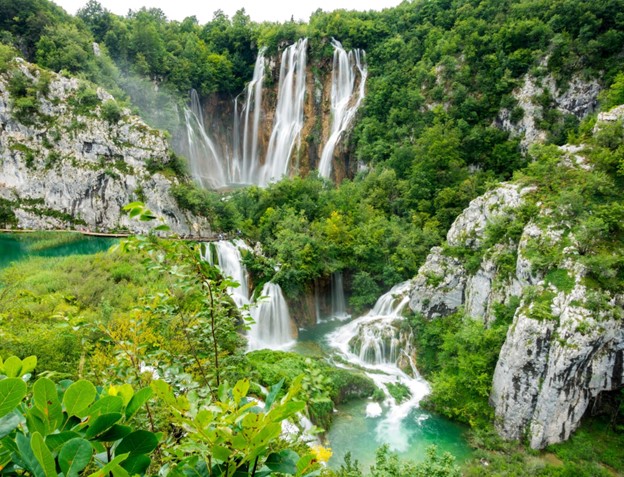
Plitvice Lakes
Welcome to Plitvice Lakes. It is Croatia’s oldest and largest national park and a UNESCO World Heritage Site. Your days 3 and 4 in Croatia will be spent exploring the natural beauty of Plitvice, with stunning lakes, waterfalls, and boardwalk trails. It is one of the best highlights of a trip to Croatia for nature and adventure lovers.
From Zagreb, you can avail of a bus service from the main bus station to save time and avoid possible hassles.
Day 3: Lower Lakes
Make sure to book your 2-day ticket in advance, as tickets to Plitvice Lakes National Park often get sold out really quickly.
Before exploring the area, let me share the following seven routes through the park: Plitvice offers seven routes to the park, also called programs. The programs are suggested routes depending on your starting point, energy level, and allotted time for the Plitvice adventure.
- Programs A, B, and C start at Entrance 1.
- Programs E, F, and H start at Entrance 2.
- Program K is a full-day hike to the whole park.
Program K is an 18-kilometer walk through all the park’s lakes, skipping the boats and shuttle.
It is worth visiting both the lower and upper sides of the lakes. Our recommended route for you to visit both locations is to combine Programs C and E and walk the hiking trails of cliff views for both parts of the lake.
Start at Entrance 1 if you enter the park early in the morning. Starting in Entrance 1, you will walk towards the waterfalls uphill most of the time, but you will also walk towards the waterfalls in the lower lakes.
With its 16 lakes and over 90 waterfalls, the Plitvice Lakes site has many trails to explore and conquer. Walking around the scenic park is one of the focuses of Plitvice, but there are other activities you can do during your 2-day stay here.
One of the best ways to learn more about this UNESCO World Heritage Site is to join a guided tour of the Plitvice Lakes. You will be guided around the lower lakes, the upper lakes, and the big waterfall.
As you enter the park through Entrance 1, walk down to the lower lakes. The trail to the lower lakes is somehow challenging, with inclines and steps all the way.
The Lower Lakes section features four of the sixteen lakes that comprise the Plitvice system.
The Great Waterfall (Veliki Slap)
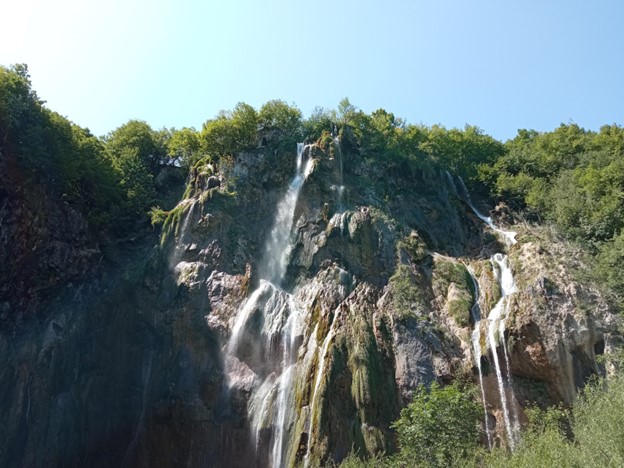
The Great Waterfall
As you arrive at the Lower Lakes, you will be greeted by this breathtaking waterfall. The Great Waterfall is the main attraction of Plitvice. It is considered the most beautiful and the highest one in Plitvice.
Boardwalk Trails
This walking route is perfect for soaking in the stunning natural landscape of the park without exerting too much energy. You’ll get to walk on the boardwalks stretching over the crystal-clear lakes, providing an up-close view of the water and the fish swimming below.
Kozjak Lake
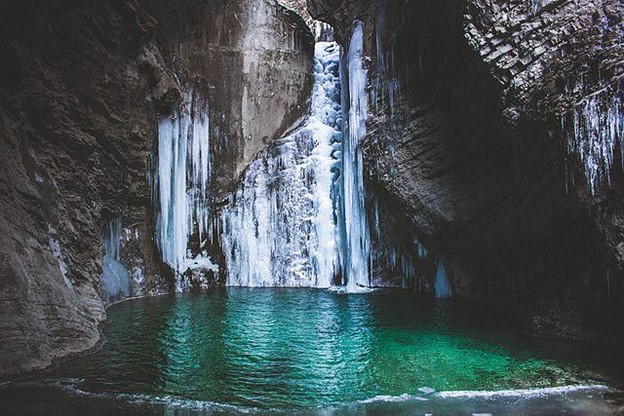
Kozkaj Lake
Kozjak Lake is the largest and deepest in the Plitvice Lakes system. You’ll get to admire this stunning lake and its picturesque scenery. You may also join a guided tour of Kozjak Lake.
From here, you can follow the signs toward food and toilets. Enjoy your lunch here, and be prepared for your next place to explore.
Šupljara Cave
While exploring the Lower Lakes Boardwalks in Plitvice Lakes, don’t miss out on the stunning Šupljara Cave. It may be a “walk by,” but it’s definitely worth stopping for a quick look and maybe even a photograph. The cave is located in the lower lake section of Kaluderovac and is a hidden gem that you won’t want to miss. As you walk through the limestone canyon, you’ll be surrounded by cliffs towering 20–40 feet high, creating a unique and awe-inspiring experience. The cave is nestled in the heart of Lika and has been around for years, providing visitors with a unique glimpse into the area’s geological formations.
Day 4: Focus on the Upper Lakes
On your second day, we suggest starting as early as possible to avoid the crowd that usually starts at 10:00 a.m.
Start at Entrance 2.
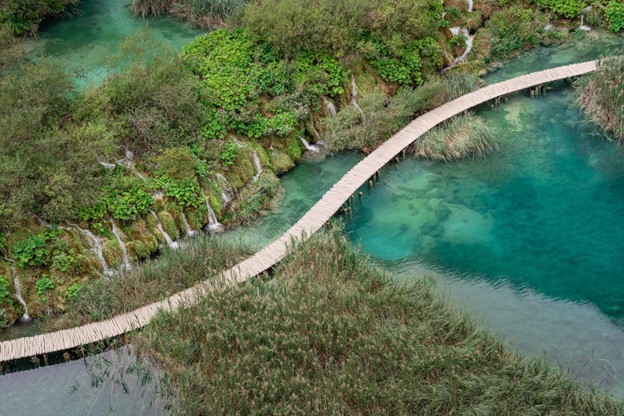
Plitvice
From entrance 2, take a short boat ride from P1 to P2. As soon as you exit the boat, you will discover that there is only one path to follow. Today’s plan is to complete a loop around the upper lakes along the lake edge. The “E” path will take you to the highest point, located at Tram Station 3 (St. 3).
As you pass the scenic boardwalk, you will see a number of waterfalls varying in size, height, and power.
You would want to bring your own food and drinks, as food and drinks are often expensive in the area.
Bike Tour of the Plitvice Valley
Spend your afternoon by joining a bike tour along the Plitvice Valley. This is a guided bike tour that lasts for 4-5 hours. The tour will take you through natural forests and the vast national park, passing through iconic structures and sites along the way, such as the Old Fortress (built in the eleventh century), the neighboring Barac Caves, and the watermill on the Korana River.
For dining options, visit Bistro Vucnica to eat a good pizza with a nice view.
After exploring Plitvice, it is time to leave and ride a bus to your next destination, Zadar.
Day 5-6: Zadar
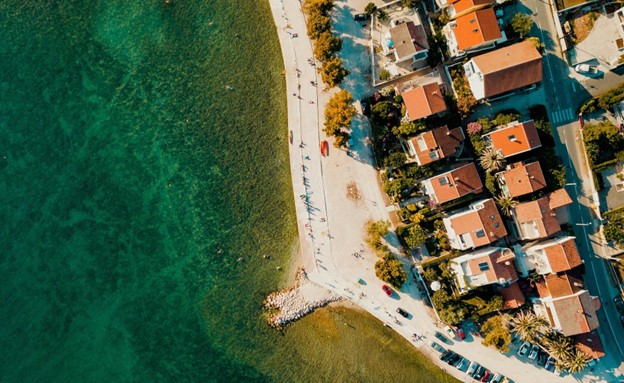
Zadar
Zadar is a charming city on the Adriatic Sea with much to offer, from its pedestrianized Old Town filled with historical and cultural sights to its stunning beaches. Zadar is also a gateway to some of the most attractive beaches in Croatia.
And if you’re fond of history and heritage, you’ll be fascinated by the rich cultural heritage of Zadar, which is acknowledged by UNESCO. Get a chance to explore the city’s charming streets, sample delicious local cuisine, and experience the warm hospitality of the locals.
Day 5: Explore the Old Town
Welcome to the charming Old Town of Zadar. As you begin exploring this historic town, you will feel like you are traveling through time as historic buildings and monuments are scattered in every corner of the town. With its Roman ruins, medieval churches, and tranquil squares adorned with delightful cafes and restaurants, Zadar’s Old Town is a true gem waiting to be discovered. You won’t even need a car to get around; simply take a leisurely stroll and absorb the enchanting ambiance of this idyllic city.
You can also join a guided walking tour. It is a good option if you have limited time or if you want to get a feel for the place.
Roman Forum
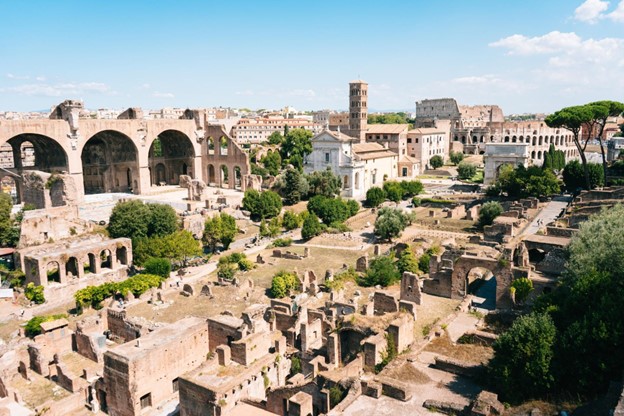
Roman Forum
Start your day by heading to the Roman Forum. It is the largest and most important archeological site in the town. It was the center of ancient Zadar’s political, religious, and commercial life.
Today, only a few remnants remain, but on its base, you will see the church of St. Donatus and other religious buildings, adding to the town’s rich history.
Pillar of Shame
A pillar of shame or column of shame was built during Roman times. It was used to humiliate people in public. The column is still standing today and is one of Zadar’s most famous and photographed landmarks. You can see the pillar in the main square near St. Donatus Church.
Saint Donatus Church
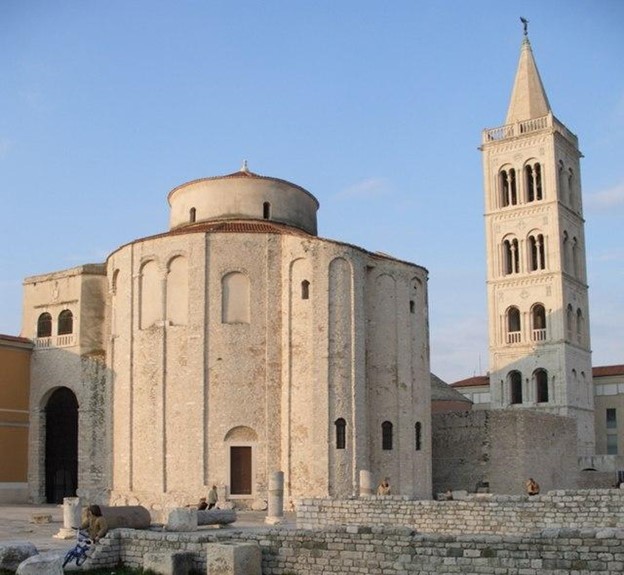
Saint Donatus Church
Next, head to Saint Donatus Church. The circular design of the church, with its distinctive dome and intricate details, makes it a unique and stunning sight to behold. You can explore the interior and admire the beautiful decorations, including intricate stone carvings and ornate frescoes.
From the church’s top, you can also enjoy breathtaking views of the surrounding area, including the Adriatic Sea and the nearby Roman Forum.
Narodni Trg
Another must-visit spot in Old Town Zadar is Narodni Trg, or People’s Park. It is one of Zadar’s Old Town’s most popular and bustling public spaces. This park is surrounded by historic buildings and is a hub of activity, with numerous cafes, restaurants, and shops lining its streets.
Visit one of the restaurants in the square and indulge in Dalmatian cuisine with a cup of strong Croatian coffee while enjoying the historic buildings around you, like Town Hall, the City Guard, and the 11th-century church of St. Lovre.
City Walls
When in Zadar, adding the city walls to your bucket list is a must. These ancient defenses have survived for centuries, guarding the city against attackers and providing a special window into Zadar’s past.
Start your visit at one of the wall’s gates, either the Land Gate or the Sea Gate, which are both spectacular structures in their own right. From there, you may stroll along the walls, which provide breathtaking views of the area and the sparkling waters of the Adriatic Sea.
You will come across a number of bastions as you explore the walls, each with its own architectural style and history. The Pentagonal, Square, and Round Towers are a few of the most noteworthy bastions.
You will get the chance to learn about the city’s past and how the walls were essential to its defense throughout your stay. Additionally, you’ll gain an understanding of Zadar’s historical development, from its early years as a Roman town to its more recent years as a bustling seaside city.
Riva Promenade and Sea Organ
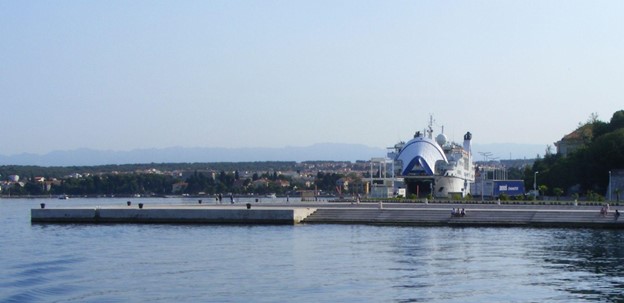
Sea Organ
Riva is a charming waterfront promenade that runs beside the Old Town’s edge and provides breathtaking views of the Adriatic Sea and the surrounding islands.
You will see and hear various things as you stroll down the promenade. Along with hearing the sound of seagulls flying overhead and the soft lapping of the waves on the shore, you’ll observe locals and visitors alike taking advantage of the warm weather and sea breeze.
Along the way, you can stop at any number of eateries, cafes, or bars for a tasty snack or refreshing drink. Many of these places have outdoor seating, so you can unwind and enjoy your meal or drink while enjoying the lovely scenery.
At the promenade’s end is a famous architectural structure called the Sea Organ, which harnesses the power of the waves to create wonderful music. The organ is a well-liked attraction for tourists and residents, providing a singular experience that is unmatched anywhere else on the globe.
Sun Salutation
Architect Nikola Baic created an urban piece called “The Sun Salutation.” A total of 300 multi-layered glass panels make up this structure, which both absorb and emit light when exposed to sunlight. Evenings are the best time to view this mesmerizing show of light while listening to the Sea Organ’s calming tones.
For dining options, visit Bistro Kalelarga or Foša restaurant. Bistro offers local cuisine with a view from its outdoor terrace. If you are craving seafood, head to Fosa. They are known for serving delectable seafood in a beautiful outdoor area near the Land Gate.
Day 6: More of Zadar
You will explore some of the places and activities that will help you see a different side of Zadar and create unforgettable memories that will last a lifetime.
Paklenica National Park
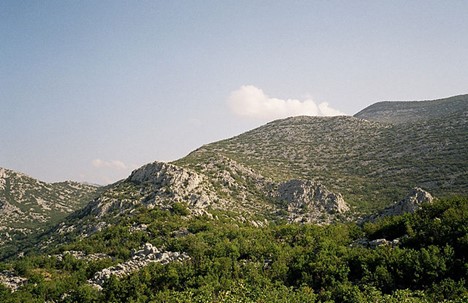
Paklenica National Park
Paklenica National Park is great for hiking and offers some of the best rock-climbing opportunities in Croatia. The park has over 360 climbing routes of varying difficulty levels, making it an excellent destination for both beginner and experienced climbers.
Kolovare Beach
After hiking Paklenica National Park, cool off at one of the beaches near and around Zadar. Head to Kolovare Beach, one of the most famous beaches in Zadar. There are several water activities available at Kolovare Beach, including paddle boats, jet skis, and parasailing. You can also rent snorkeling equipment and explore the underwater world. Or if you want to relax on the beach, there are beach benches and umbrellas that you can rent for a minimal fee.
There are also several beach bars and restaurants where you can grab a drink or a bite to eat while waiting for the sunset at the beach. Watching the sunset at Kolovare Beach is a must-do activity. The colors of the sky and the sea make for a stunning backdrop, and there are several restaurants and bars where you can enjoy a drink or a meal while taking in the view.
Spend some time unwinding and recharging your energy level before you depart for Split the following morning.
Day 7–10 Split
Split, Croatia, is a stunning coastal city located on the Adriatic Sea. It is renowned for its rich past, stunning architecture, and crystal-clear waters. With so much to see and do, four days in Split are the ideal length of time to experience this charming location. Split has much to offer everyone, whether you’re interested in discovering old Roman ruins, exploring quaint streets, or relaxing on the beach. Split is bound to leave you with lifelong memories, from its vibrant markets to its charming port.
Day 7: Old Town
As you arrive in Split, your first day will be spent exploring the historic and architecturally rich Old Town of Split.
Diocletian’s Palace
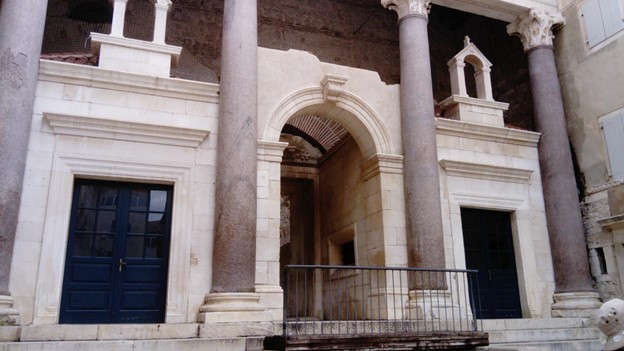
Diocletian’s Palace
Start your day in Split by heading to one of Croatia’s most famous tourist destinations, Dioletin’s Palace. This 4th-century palace is the heart of Split’s Old Town and should be on your list of places to visit in Croatia. It was declared a UNESCO World Heritage Site in 1979.
Its massive walls enclose a 10-acre maze of temple ruins, apartments, hotels, museums, markets, coffee shops (offering rich Croatian cakes and pastries), contemporary stores, and even an old cathedral, all interlaced together with cobblestone pathways that are only accessible by foot.
Peristyle
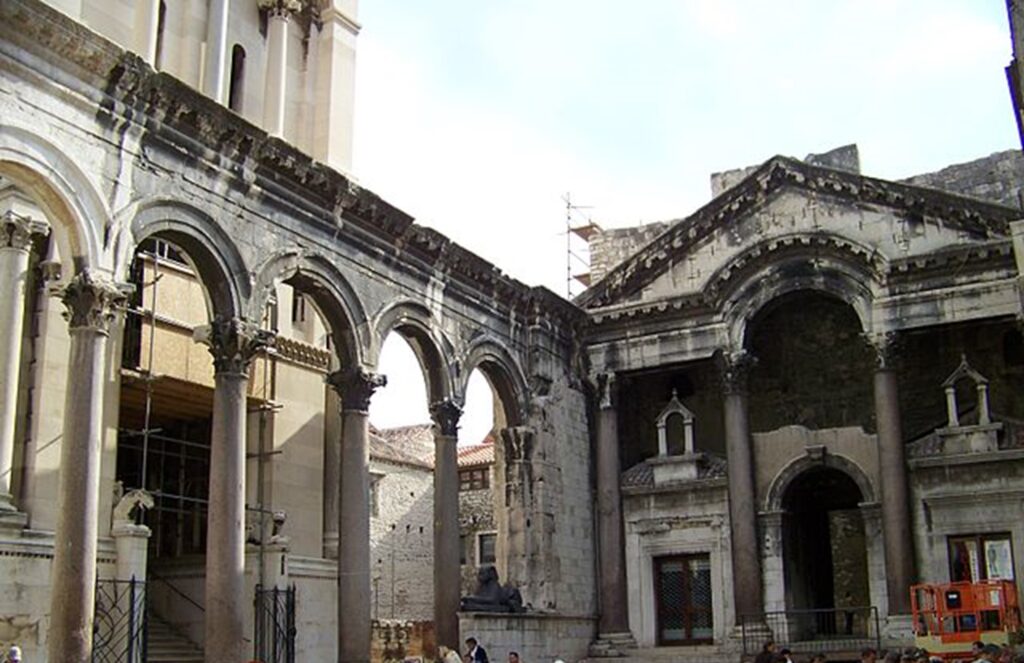
Peristyle
The Peristyle is the central square of Diocletian’s Palace and is considered to be the most charming part of the Old Town. The narrow streets leading to Peristyle are lined with ancient architecture and stone carvings. Upon entering the square, you’ll be greeted by columns and a domed ceiling that create a grand and impressive atmosphere.
There are many restaurants and cafes located around Peristyle. You can enjoy a meal or a cup of coffee while soaking in the atmosphere of this historic square.
Cathedral of Saint Domnius
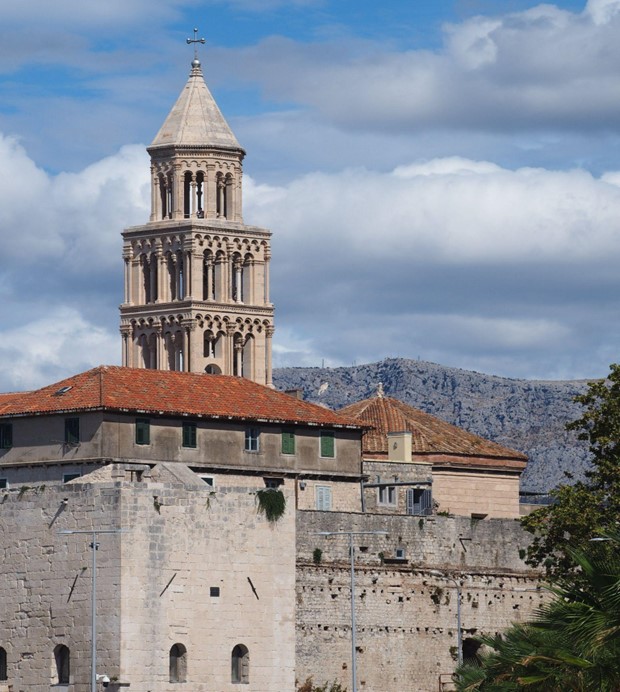
Cathedral of Saint Domnius
Located within Diocletian’s Palace, this stunning cathedral dates back to the 7th century and features intricate stone carvings and a bell tower with panoramic city views. Along with the northern walls of the palace, which have been used to represent the city since the Middle Ages, the bell tower has come to be identified as the city’s emblem and is the key element on the coat of arms.
Ethnographic Museum Split
This museum offers a fascinating look at the history and culture of the Dalmatia region, including traditional costumes, jewelry, and tools.
The museum is dedicated to preserving and showcasing the cultural heritage of the Split region. It has a gift shop that sells a variety of souvenirs, including traditional crafts and handmade items.
The Golden Gate
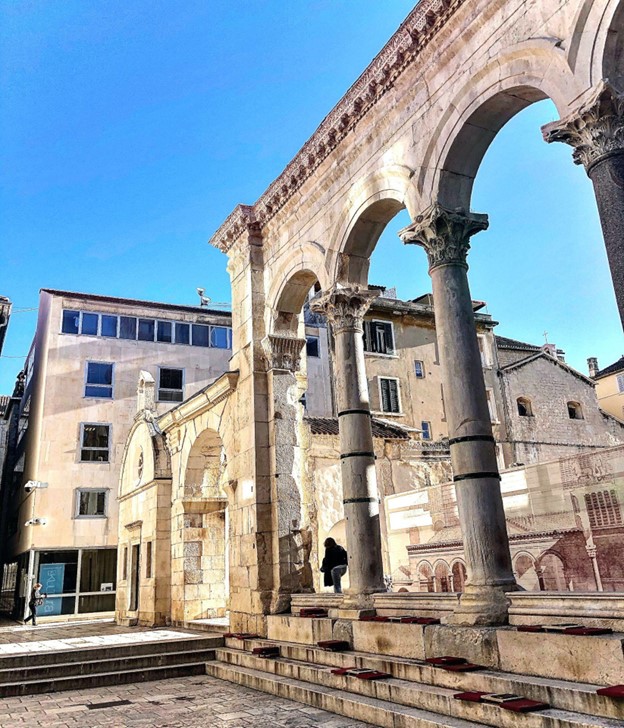
The Golden Gate
The magnificent Golden Gate provides access to Diocletian’s Palace. Before, only the emperor and his family were allowed to walk through this special gate. Nowadays, it is a popular meeting point for tours starting inside the old town. Another sight is directly opposite: the approximately 8-meter-high statue of Bishop Gregory of Nin, a work by the most famous Croatian sculptor, Ivan Meštrović.
For your training, drop in at CrossFit XV.
Day 8: Day Trip to Krka
Day 8 of your trip to Croatia will be spent exploring the Kyka National Park. It is a beautiful destination for hiking enthusiasts, with a variety of trails that offer stunning views of the park’s waterfalls, rivers, and canyons.
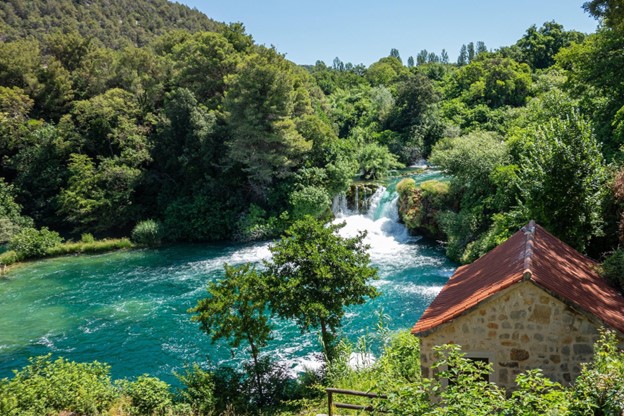
Skradinski Buk Hiking Trail
This is the most popular hiking trail in the park, and it takes you through the heart of the park’s most famous waterfall. The trail is about 1.5 kilometers long and takes about an hour to complete. Along the way, you’ll see cascading waterfalls, lush vegetation, and stunning views of the Krka River.
Roski Slap Hiking Trail
This trail takes you through the park’s second-largest waterfall, Roški Slap, and its surrounding nature. The trail is about 3.5 kilometers long and takes about 2 hours to complete. You’ll see stunning waterfalls, wooden bridges, and ancient mills that were once used for grinding wheat.
Krka Monastery Hiking Trail
This trail takes you to the historic Krka Monastery, located in the northern part of the park. The trail is about 6 kilometers long and takes about 3 hours to complete. You’ll hike through forests and fields and see traditional Dalmatian houses along the way.
Krka Canyon Hiking Trail
This trail takes you through the park’s stunning canyon, carved out by the Krka River. The trail is about 8 kilometers long and takes about 4 hours to complete. You’ll hike along the river, cross wooden bridges, and see beautiful waterfalls and cascades along the way.
The park has several dining options available for you, ranging from casual cafes to more upscale restaurants. Restaurant Krka is a great option if you are looking for a more upscale dining experience. It is conveniently located near the park entrance; the restaurant offers a wide range of traditional Croatian dishes, including fresh seafood, grilled meats, and local specialties. It has both indoor and outdoor seating, with the outdoor terrace offering stunning views of the Krka River.
Day 9: More of a Split
Your last day in Split will be spent slowing down and enjoying the things this place offers. There’s no better way to appreciate it than to take a break from the hustle and bustle and soak in the atmosphere.
Visit Green Market
Visit the Green Market in Split to start the day. Its location in the center of the old town makes it a center of activity for both locals and visitors.
One of the highlights of the Green Market is the fish section, where fishermen sell their daily catch. In addition to offering delicious food, the Green Market is a terrific location for people-watching and soaking up the neighborhood vibe.
Marjan Hill
Located just outside of the city center, Marjan Hill is a nature reserve with numerous walking and cycling paths. You can hike to the top of the hill for panoramic views of the city and the sea. The hill is also home to several small beaches and secluded coves where you can swim and sunbathe.
Saint Nicholas Church
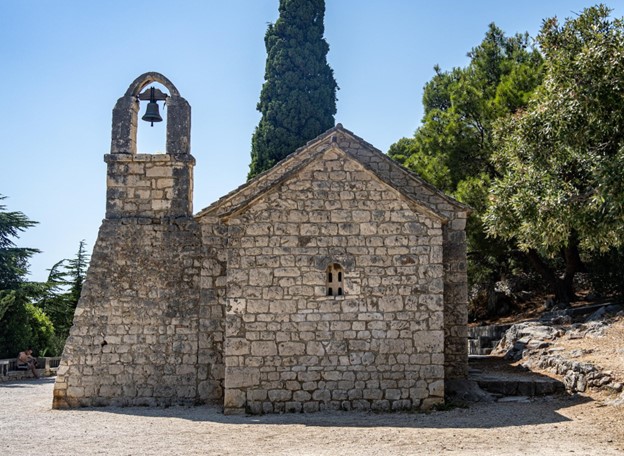
Saint Nicholas Church
Bacvice Beach
This popular beach is just a short walk from the city center and is known for its soft sand and clear water. Plenty of cafes and restaurants are nearby where you can grab a drink or a bite to eat, and the atmosphere is relaxed and laid-back.
Veli Varos
This historic neighborhood is located just west of the city center and is known for its charming narrow streets and traditional stone houses. It’s a great place to wander and explore without the crowds of the city’s more touristy areas.
After a day full of hiking experiences, it is time to ride back to Split. Don’t forget to get your training in by dropping in at Crossfit Split.
Day 10: Day Trip to Trogir
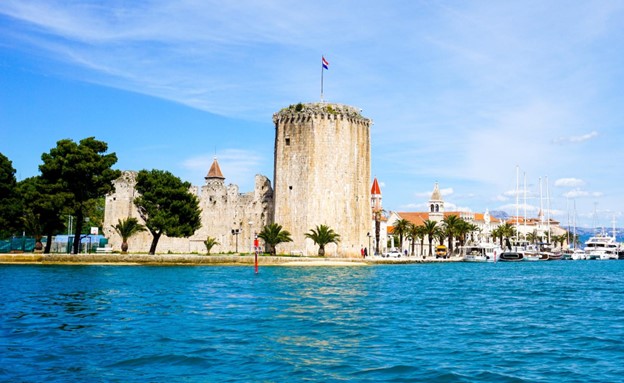
Trogir
Located just 30 minutes from Split by bus or car, Trogir is a charming medieval town that has been designated a UNESCO World Heritage Site. With its narrow cobblestone streets, ancient churches, and beautiful Venetian-style architecture, Trogir is a popular destination for history and architecture buffs.
Trogir Old Town
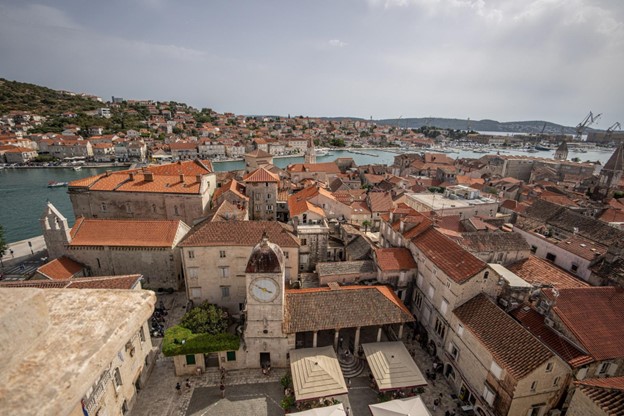
Trogir Old Town
Trogir’s historic Old Town is a UNESCO World Heritage Site and one of Europe’s best-preserved medieval towns. The Old Town is filled with narrow cobblestone streets, ancient churches, and beautiful Venetian-style architecture. Be sure to visit the St. Lawrence Cathedral, the Kamerlengo Fortress, and the Cipiko Palace, all of which are must-see attractions in the town.
Trogir Market
Trogir’s bustling market is a great place to explore and get a taste of local life. Here you’ll find a variety of fresh produce, meats, cheeses, and other local specialties, as well as souvenirs and other items. The market is located just a short walk from the Old Town and is open daily.
Cipiko Palace
The Cipiko Palace is a beautiful Renaissance-era palace located in the heart of the Old Town. The palace was built in the 15th century and is one of Croatia’s most impressive examples of Renaissance architecture. The palace is now home to the Town Museum, which showcases the history and culture of Trogir and the surrounding area.
Kamerlengo Fortress
The Kamerlengo Fortress is a well-preserved medieval fortress located on the waterfront in Trogir. The fortress was built in the 15th century to defend the town from invaders and offers stunning views of the town and the Adriatic Sea.
Trogir Marina
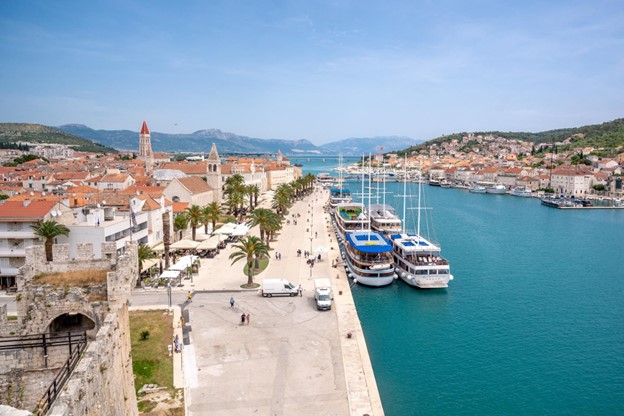
Trogir Marina
Trogir Marina is a great place to go for a walk and admire the beautiful boats and yachts, or simply admire the beautiful scenery in Trogir. There are several restaurants and cafes where you can grab a drink or a meal while watching the boats come and go.
After a day in Trogir, it’s time to head back to Split to prepare for your next destination, Dubrovnik.
Day 11–14: Dubrovnik.
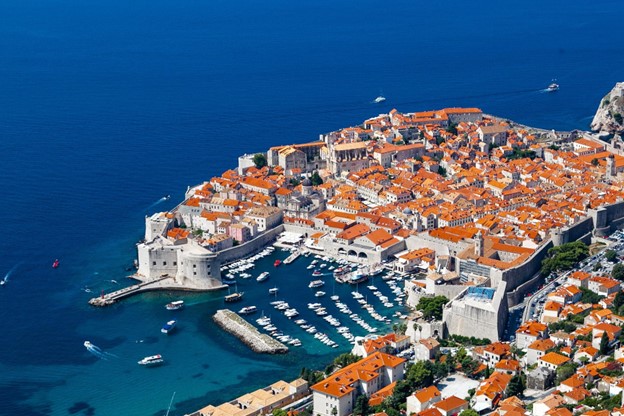
Dubrovnik
Referred to as the “Pearl of the Adriatic,” it is a stunning city on Croatia’s southern coast. With its ancient walls, narrow streets, and beautiful beaches, it’s no wonder why Dubrovnik has become a top travel destination in recent years. If you plan to visit Dubrovnik for four days, you’ll have plenty of time to explore the city’s many attractions and surrounding area.
Day 11: Old Town
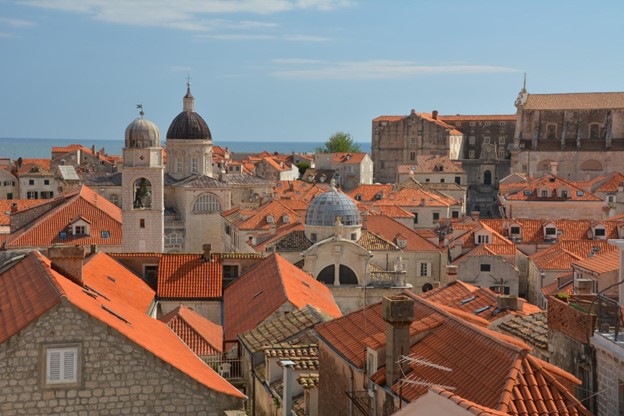
Old Town
As you arrive in Dubrovnik, your first day will be spent exploring the Old Town. The Old Town is a UNESCO World Heritage Site that attracts millions of tourists every year. As you wander the narrow alleyways, you will discover beautiful buildings, impressive monuments, and charming cafes that will give you a glimpse of the past in this fascinating city.
Old Town Wall
Sightseeing in Dubrovnik should ultimately include the walls of the Old Town.
We recommend starting early, as the wall site gets crowded during peak hours. You can join a guided walking tour or explore the walls independently. As you walk up the steps, you will be rewarded with panoramic views of Stradun and the terracotta skyline of the Old Town. Visit the Minceta Tower; the fortress was built in the 14th century and is the highest point of Dubrovnik.
Onofrio’s Fountain
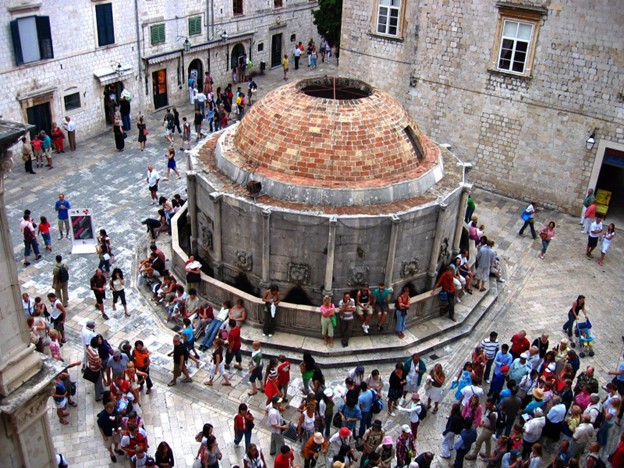
Onofrio’s Fountain
Onofrio’s Fountain is a popular tourist attraction located in the heart of Old Town Dubrovnik, Croatia. The fountain was built by Italian architect Onofrio della Cava in the 15th century.
The fountain is located at the western end of Stradun, the city’s main street, and is easily accessible by foot.
As you approach the fountain, you’ll notice its distinctive circular shape and ornate design. The fountain features 16 carved stone masks that spout water from their mouths, and the water flows into a large basin at the fountain’s base.
Franciscan Monastery
The monastery is located near the Pile Gate entrance to Old Town and is easily accessible by foot. As you approach the monastery, you’ll be struck by its impressive architecture and serene atmosphere. The monastery features a beautiful courtyard, a Gothic cloister, and a stunning Baroque church that is well worth a visit.
One of the highlights of the Franciscan Monastery is its impressive library, which contains more than 30,000 volumes, including many rare and ancient manuscripts. Visitors can take a guided tour of the library to learn more about its history and see some of its most significant treasures.
Another notable feature of the monastery is its pharmacy, which has operated since the 14th century and is one of the oldest still-functioning pharmacies in Europe. Visitors can see an impressive collection of antique jars, bottles, and other medical instruments and learn about the region’s history of medicine and pharmaceuticals.
Pile Gate
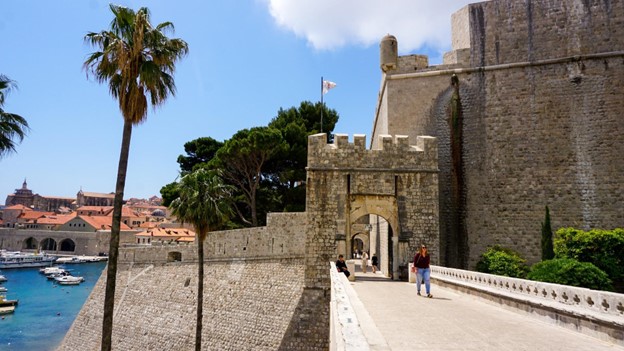
Pile Gate
The Pile Gate is one of the main entrances to Dubrovnik’s Old Town, Croatia. Located on the western end of the main street, Stradun, the gate was built in the 14th century and has served as a crucial access point to the city ever since.
As you approach the Pile Gate, you’ll be struck by its impressive stone walls and imposing presence. The gate features a drawbridge and a wooden door that can be closed to protect the city from invaders. The gate also features a statue of Saint Blaise, the patron saint of Dubrovnik, symbolizing the city’s faith and heritage.
Once you pass through the Pile Gate, you’ll find yourself in the heart of Dubrovnik’s Old Town. The streets are lined with beautiful buildings, charming cafes, and historic landmarks, including the Franciscan Monastery and the Sponza Palace.
Sponza Palace
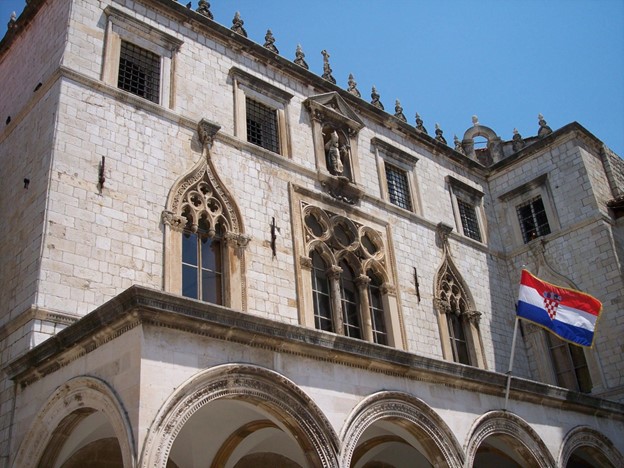
Sponza Palace
The Sponza Palace is a significant historical building located in the heart of Dubrovnik’s Old Town, Croatia. It is one of the most prominent landmarks in the city and is renowned for its impressive architecture and rich history.
Built in the 16th century, the palace blends Gothic and Renaissance styles with a beautiful stone facade, ornate carvings, and intricate details throughout. It was originally used as a customs house and a center for trade and commerce, and it served as a hub for cultural exchange and diplomacy. The palace’s impressive atrium is also used as a venue for weddings, receptions, and other special events, and it is a popular spot for taking photographs.
Mt. Srd
A visit to Dubrovnik is not complete without experiencing a Dubrovnik sunset. The mountain is located just behind the Croatian city of Dubrovnik and provides a stunning vantage point from which to watch the sun go down. Visitors to Mount Srd are able to take in one of the best views in the country.
It’s a popular tourist attraction in Dubrovnik, offering stunning panoramic views of the city and the Adriatic Sea from its summit.
The most popular hiking route starts from the bottom of the hill near the Old Town and takes about 1.5 to 2 hours to reach the summit. The trail is well-marked and offers beautiful views of the city and the surrounding coastline along the way. It’s a moderate hike with some steep sections and uneven terrain, so it’s important to wear appropriate footwear and bring enough water and snacks for the trip.
Day 12: Beach Area and Sunset

Dubrovnik
Dubrovnik is a city surrounded by beautiful beaches and crystal-clear waters, making it a popular destination for beachgoers. Your second day in Dubrovnik will be spent hopping between beaches and soaking up the crystal-clear waters and stunning views of the Adriatic Sea.
Banje Beach
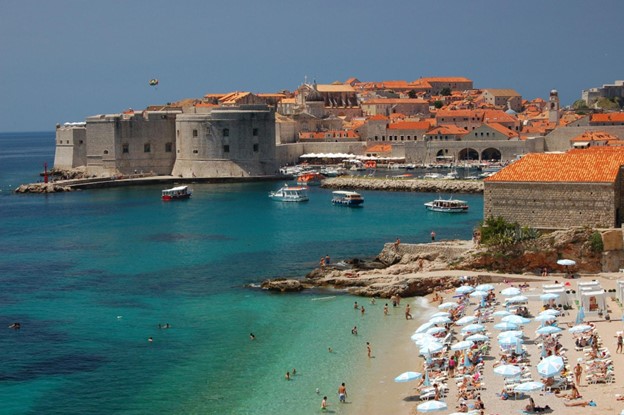
Banje Beach
Banje Beach is a great choice to start your second day in Dubrovnik. It’s one of the city’s most popular and well-known beaches and is just a short walk from the Old Town.
Banje Beach offers a stunning view of the Old Town and the city walls, making it a great spot for taking photos and admiring the beauty of Dubrovnik. The beach is also lively, with plenty of sun loungers, umbrellas, and water sports equipment for rent.
In addition to swimming and sunbathing, there are plenty of activities to enjoy at Banje Beach, such as jet skiing, parasailing, and beach volleyball.
Be sure to grab a refreshing drink and meal at one of the several restaurants nearby.
Sveti Jakov Beach
Sveti Jakov Beach is a beautiful pebble beach located about 2 kilometers from the Old Town. It’s quieter than Banje Beach but still offers stunning views of the city walls and crystal-clear waters. There are stairs leading down to the beach, and you’ll find some sun loungers and umbrellas available to rent.
Copacabana Beach
Copacabana Beach is a family-friendly beach located in the Babin Kuk area of Dubrovnik. Children can play safely in the shallow seas and sand of this beach. Sun loungers, umbrellas, and equipment for water sports are just a few of the amenities. The beach is a terrific location for a meal with a view because it also includes a promenade with cafés and eateries.
Buza Beach Bar
If you’re looking for a good spot to watch the sunset from a beach in Dubrovnik, one great option is the Buza Beach Bar. It’s located just outside the city walls near the Buza Gate and offers a stunning view of the sunset over the Adriatic Sea.
The bar itself is built into the cliffs overlooking the sea, and there are several levels of terraces where you can relax with a drink and enjoy the view. The atmosphere is laid-back and romantic, making it a popular spot for couples and travelers looking for a unique experience.
Day 13: Explore Cavtat
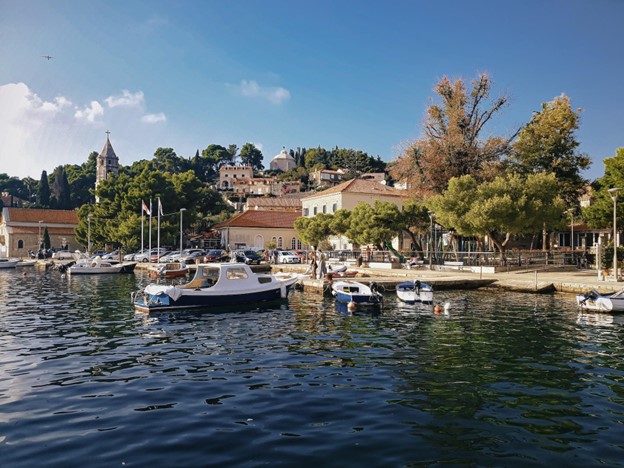
Cavtat
Cavtat is a picturesque beach village close to Dubrovnik. It’s a well-liked vacation spot famous for its lovely beaches, pristine waters, and breathtaking Adriatic Sea vistas. Cavtat is a wonderful day trip location for tourists wishing to explore the area since it provides a gentler alternative to the bustle of Dubrovnik’s Old Town with its charming streets, historic structures, and laid-back vibe.
Racic Mausoleum
The Racic Mausoleum is a stunning architectural masterpiece located in the town of Cavtat, just south of Dubrovnik.
The mausoleum is a memorial to the Racic family, notable figures in the locality. Its beautiful carvings and sculptures show scenes from Jesus Christ’s life and are entirely made of white stone.
In addition to the mausoleum, visitors can enjoy its beautiful gardens. The gardens are a wonderful place for a quiet stroll or a picnic because they are surrounded by lush flora and provide excellent views of the surrounding environment.
ATV Ride with Kojan Travel
Kojan Koral’s ATV rides take you on a thrilling adventure through the rugged terrain and stunning landscapes surrounding Dubrovnik. The ride is suitable for both beginners and experienced riders, as the staff provides a safety briefing and instructions before the ride.
During the ATV ride, you’ll get to see some of the most beautiful spots in the area, including hidden beaches, lush forests, and stunning viewpoints. You’ll also have the opportunity to stop and take photos of the scenery, making it a great way to capture some amazing memories of your trip.
The ATV ride is a great activity for families, groups of friends, or anyone looking for an exciting and unique way to experience the outdoors in Dubrovnik.
Konavle Valley
The Konavle Valley is a scenic region located south of Dubrovnik, known for its picturesque countryside, charming villages, and stunning coastline. Cycling is one of the best ways to discover this stunning region, and the tiny village of Komaji is a well-liked cycling tour starting point.
The Konavle Valley’s center, Komaji, offers quick access to a number of beautiful riding routes. You can rent a bike from one of the local shops or join a guided cycling tour to explore the area with an experienced guide.
The cycling routes in the Konavle Valley are suitable for all levels of experience, with options ranging from leisurely rides through the countryside to more challenging mountain biking trails. Along the way, you’ll have the opportunity to stop and explore charming villages, taste local wines and delicacies, and take in the region’s stunning scenery.
Some popular destinations to visit while cycling in Konavle Valley include the historic Sokol Grad fortress, the picturesque seaside town of Cavtat, and the traditional village of Ljuta. You can also take a break and relax on one of the many beautiful beaches along the coast.
Cadmos Village
Cadmos Village is an adventure park located in the Konavle Valley, just a short drive from Dubrovnik. The park is known for its thrilling zipline tours, which offer visitors an exhilarating and unique way to experience the region’s stunning natural beauty.
The zipline tour at Cadmos Village consists of several zipline lines ranging from 150 meters to 900 meters. The tour soars high above the trees, giving you a bird’s-eye view of the beautiful Konavle Valley below. You can stop at several platforms and take in the area’s stunning scenery along the way.
The zipline tour is suitable for all experience levels, from beginners to advanced thrill-seekers. The experienced and professional guides at Cadmos Village provide all the necessary safety equipment and training to ensure a safe and enjoyable experience for all.
In addition to the zipline tour, Cadmos Village offers a range of other adventure activities, including horseback riding, ATV tours, and paintball. There’s also an on-site restaurant and bar where you can relax and refuel after your adventure.
Day 14. Day Trip to the Peljesac Peninsula
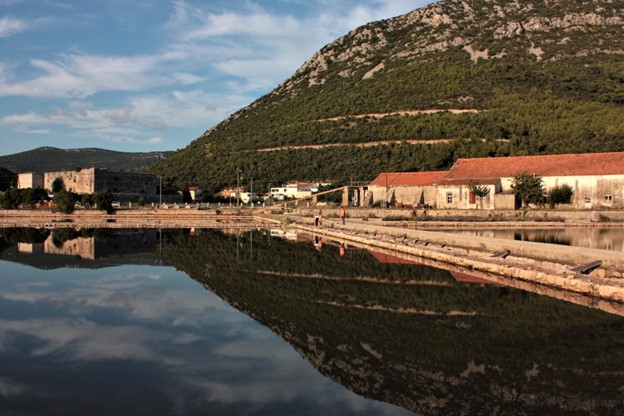
Peljesac
Your last day in Croatia will be spent exploring the Peljesac Peninsula. It is a stunning southern Croatian region known for its rugged coastline, beautiful beaches, and excellent local cuisine. If you’re visiting Dubrovnik, a day trip to the Peljesac Peninsula is a must-see destination.
Wine Tasting
The peninsula is known for its wine production, especially the red wine variety Plavac Mali, which is grown in the Dingac and Postup regions. You can visit several wineries and vineyards to sample some of the local wines and learn about the winemaking process.
Beach
In addition to wine tasting, the Peljesac Peninsula offers plenty of other activities for tourists. You can explore the beautiful coastal beaches, swim or snorkel in crystal-clear waters, or take a boat tour to explore the nearby islands.
Our top recommended beaches to visit on the Peljesac Peninsula are:
Prapratno Beach
Prapratno Beach is a popular beach on the Peljesac Peninsula. It lies on the peninsula’s southern coast. It is known for its crystal-clear water, white sand, and lush greenery, which provide a stunning view of nearby islands. It is suitable for swimming, sunbathing, and enjoying water sports.
Trstenica Beach
Trstenica Beach, which is situated on the peninsula’s northern coast, is another well-liked tourist destination. There are numerous facilities available at this lengthy pebble beach, including restaurants, cafes, and beach bars. The water is incredibly clear, calm, and shallow, making it perfect for families with young children.
Duba Beach
Duba Beach is located in the small village of Duba on the western coast of the Peljesac Peninsula. It is a secluded beach with crystal-clear water, surrounded by pine trees and olive groves. It is perfect for those who want a quiet and peaceful beach experience away from the crowds.
Walk the Walls of Ston
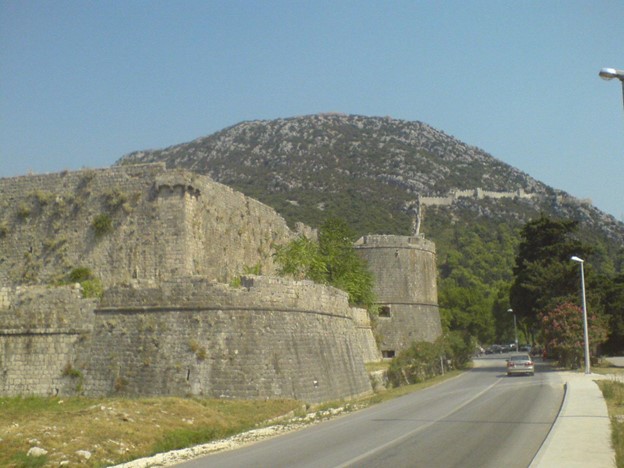
Walls of Ston
The Walls of Ston is a remarkable example of medieval fortification. The walls were constructed in the 14th and 15th centuries to defend Ston, which at the time was a significant hub for the production of salt. The walls are among the longest fortifications in Europe, at about 5.5 kilometers (3.4 miles) in length.
Walking along the walls allows you to take in the breathtaking views of the surrounding landscape, Ston, and the close-by salt pans. There are numerous towers and defenses along the walls, some of which can be scaled for even better vistas. The view of Mali Ston Bay, well-known for its mussel and oyster farms, is one of the highlights of the walls.
Walking Ston’s walls takes about two to three hours, depending on your pace. It’s also a fantastic way to spend the day, taking in the breathtaking views of the Adriatic Sea and the lovely surroundings.
After a day of exploring the Peljesac Peninsula, it’s time to return to Dubrovnik Old Town for a tasty meal and refreshing drink. Visit the Posat Restaurant, a well-liked eatery near the Ploce Gate in the center of Dubrovnik’s Old Town. It offers a mix of Croatian and Mediterranean cuisine, focusing on fresh seafood and local ingredients. The restaurant is housed in a historical structure and has a lovely terrace with views of the sea and the city walls of Dubrovnik.
As you head to the airport and prepare for your journey back home, take a moment to cherish the memories you’ve made during your 14-day stay in Croatia. We hope you had a memorable trip, whether swimming in the Adriatic Sea’s crystal blue waters, visiting historic sites, or enjoying delectable Croatian food.

